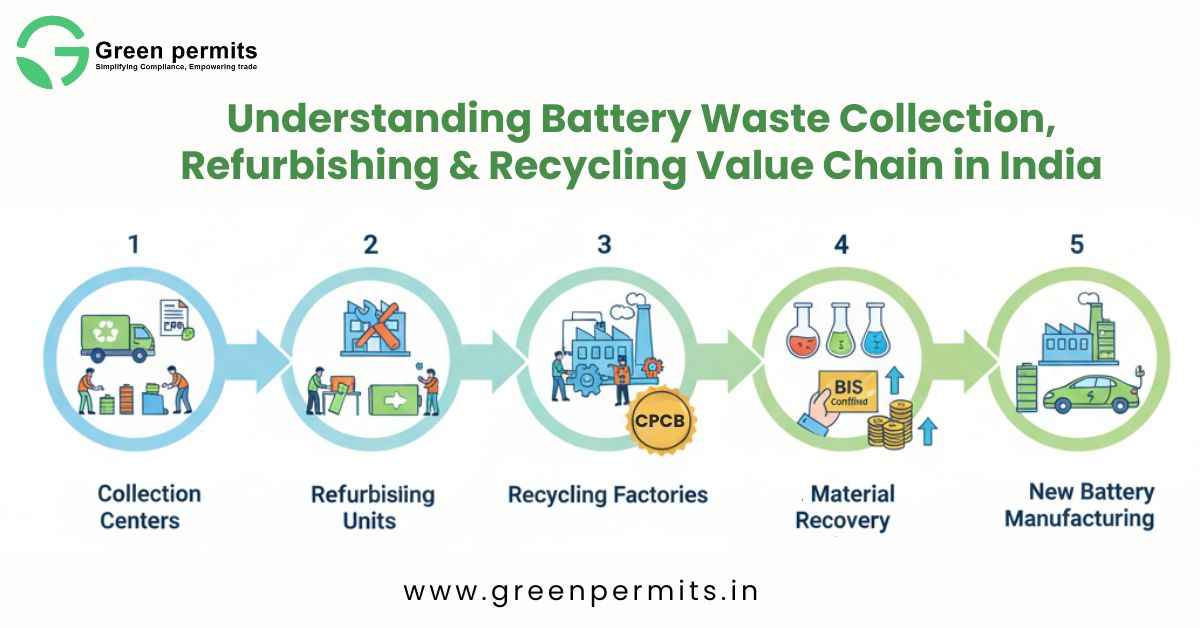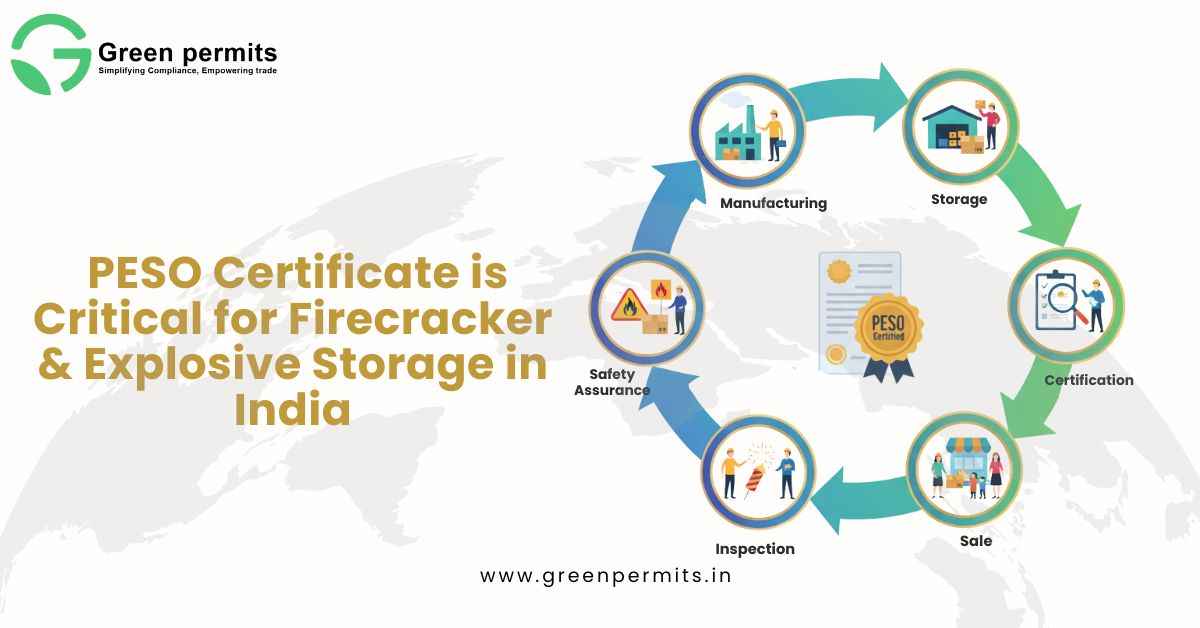Introduction — The Real-World Side of Compliance
When Ritika started her small refurbishing unit in Ghaziabad, she thought the biggest challenge would be sourcing used batteries. Instead, she found herself spending hours on data entry, filing returns, and waiting for portal approvals. One missed quarterly filing led to an Environmental Compensation (EC) notice — and a delayed shipment that cost her a major client.
Her experience is now common across India’s growing battery waste collection and recycling ecosystem. Businesses of all sizes are realizing that understanding the full value chain — from collection to refurbishing to recycling — isn’t just a compliance task. It’s the key to smoother operations, stronger customer confidence, and long-term profitability.
The Battery Waste Value Chain — Why It Matters
India’s Battery Waste Management Rules (BWMR) have transformed the way used batteries move through the economy. What was once an informal, untracked process is now a structured value chain built on Extended Producer Responsibility (EPR).
Here’s how it flows:
- Producers have the responsibility to ensure their products are collected and recycled or refurbished at the end of their life.
- Refurbishers extend battery life through repair and reconditioning.
- Recyclers recover key materials and generate EPR certificates that producers use to fulfill obligations.
Every step — from collection to recycling — must be recorded on the CPCB EPR Battery Portal. The result is a transparent system that rewards compliant players and filters out those who avoid regulation.
For businesses, this isn’t just about paperwork. Timely filings and accurate records translate into fewer penalties, smoother buyer audits, and better access to industrial contracts.
Collection and Aggregation — The First Critical Step
Battery waste collection in India operates through a mix of formal and informal channels. Aggregators, collection centers, and logistics partners play a crucial role in moving used batteries from consumers and industries to registered refurbishers and recyclers.
Why this matters for you:
If your business handles used batteries, even as part of trade or refurbishment, your documentation chain begins here. Collection records are the foundation for your quarterly return filings and EPR credits later.
Key insights:
- Maintain clear purchase invoices and GST-linked records for every lot collected.
- Work only with CPCB-registered partners to ensure traceability.
- Plan your quarter-end reconciliations early — missing data from collectors is the top cause of return delays.
When done right, this stage ensures your company’s downstream filings flow without errors and EC flags.
Refurbishing — The Overlooked Middle Layer of Circular Economy
While recycling often gets the headlines, refurbishing quietly powers India’s circular battery economy. Refurbishers take used batteries, replace cells, restore capacity, and send them back into the market with renewed life.
Under the BWMR framework, refurbishers are required to register on the CPCB portal, log every transaction, and file quarterly returns. Neglecting these steps can lead to automatic EC penalties and even license suspension.
Operational checkpoints for refurbishers:
- Complete registration through the CPCB portal with updated KYC, bank, and consent details.
- Record every batch — procurement, refurbishment, and sales — accurately within the portal.
- File the Quarterly Return (Form 4) by the end of the month following each quarter (e.g., file Q1 by July 31).
- Pay the return filing fee, which equals 25% of the registration fee, during each submission.
A real-world example:
A Pune refurbisher delayed filing by just two weeks because sales data wasn’t reconciled in time. The portal automatically levied an EC entry and temporarily froze new sales registrations. It took three months — and extra paperwork — to get back to normal operations.
Consistency, not size, protects a refurbishing business.
Recycling — Turning Waste into a Resource
The recycling phase is where India’s battery waste value chain completes its loop. Recyclers extract valuable metals such as lithium, cobalt, nickel, and lead, which can then re-enter the manufacturing stream.
But recycling is more than an industrial process — it’s also a compliance-driven business model. Recyclers must submit detailed data on procurement, processing, and sales, generate EPR credits, and transfer them through the CPCB portal.
Key actions for recyclers:
- Maintain complete digital and physical records of input waste and output material.
- File quarterly returns and ensure entries are locked before the deadline.
- Remember that “factory waste” sales don’t count toward EPR credits.
- Reconcile your data early; once the quarter closes, editing entries is restricted.
Efficient recyclers often achieve better credit realization and faster cash flow simply because their filings are error-free.
The Compliance Framework — Roles and Responsibilities
The Battery Waste Management Rules, first introduced in 2022 and refined in 2023–2025, formalized India’s circular battery economy.
Here’s what each participant is expected to do:
| Stakeholder | Key Responsibility | Compliance Requirement |
|---|---|---|
| Producer | Fulfil EPR obligations through registered refurbishers/recyclers | Register on CPCB portal, purchase EPR credits |
| Refurbisher | Extend battery life, maintain data transparency | Register and file quarterly returns |
| Recycler | Recover materials and generate EPR certificates | File quarterly and annual returns on the portal |
This centralized framework helps the government monitor waste flows and encourages compliant players to grow faster.
Compliance Risks and Penalties — The Cost of Delay
Environmental Compensation (EC) is the enforcement tool that keeps the system credible. If a business misses a filing deadline or submits incomplete data, the CPCB portal can automatically levy EC penalties.
Typical triggers include:
- Missing quarterly return deadlines (30 days post-quarter).
- Incomplete procurement or sales data.
- Inconsistencies between invoices and portal entries.
- Repeated filing errors or inactive quarters.
Penalties aren’t just financial — they can lead to status downgrades on the CPCB portal, affecting vendor eligibility and customer trust.
For small operators, a simple lapse in recordkeeping can result in a blocked EPR transaction or delayed project approval. Compliance is now directly tied to market credibility.
India’s 2025 Policy Push — The Business Advantage
Recent government actions are making battery recycling more financially viable than ever before. Two major announcements stand out:
| Policy | Change Introduced | Impact on Business |
|---|---|---|
| Customs Duty Exemption | Full exemption on lithium-ion battery waste and certain critical minerals | Lower raw material costs and improved profit margins |
| ₹1,500 Crore Recycling Incentive Scheme | Approved for FY26–FY31 to promote large-scale recycling | Support for plant setup and capacity expansion |
If your business is planning to expand or import scrap for processing, these updates can significantly improve ROI. Staying compliant today positions you to qualify for these incentives tomorrow.
Filing Timeline and Fee Structure
| Participant | Filing Type | Deadline | Fee |
|---|---|---|---|
| Producer | Quarterly & Annual Returns | As per portal schedule | As notified |
| Refurbisher | Quarterly Return (Form 4) | End of month after quarter | 25% of Registration Fee |
| Recycler | Quarterly Return & EPR Certificate | End of quarter | 25% of Registration Fee |
Filing on time ensures your profile stays active and your EPR credits remain tradable. Late submissions can automatically trigger EC penalties and portal restrictions.
Making Compliance Routine — Not Stressful
Many businesses treat filing as a last-minute task, but the most successful recyclers follow a routine checklist:
- Close procurement and sales data one week before quarter-end.
- Reconcile invoices, HSN codes, and quantities with portal entries.
- Complete internal review before submission.
- File returns early and keep acknowledgement receipts.
- Check the EC dashboard weekly to monitor any pending or waived penalties.
This discipline not only avoids penalties but also builds a record of trust with buyers and regulators.
The Big Picture — Compliance as a Growth Strategy
For most small and mid-sized recyclers, compliance initially feels like an obligation. Over time, it becomes a competitive advantage. Vendors, OEMs, and investors increasingly prefer to work with partners whose records are clean and current.
When you comply:
- You save on EC costs and avoid delays in EPR approvals.
- You improve your company’s credibility with large buyers.
- You open doors to new financing and incentive opportunities.
When you delay:
- Portal flags and EC dues pile up.
- License renewals take longer.
- Buyers hesitate to place repeat orders.
The battery waste collection value chain in India rewards discipline. A clear compliance process reduces stress, saves money, and builds long-term business resilience.
Call to Action
📞 +91 78350 06182 | 📧 wecare@greenpermits.in
Book a Consultation with Green Permits
Book a Technical Call with Expert
FAQs
Every quarter, by the end of the month following the quarter.
25% of the registration fee, payable with each filing.
No. Entries lock once the quarter closes or after submission.
No. Sales tagged as factory waste are excluded.
The CPCB portal may automatically impose Environmental Compensation until you file and clear dues.
The customs duty exemption for LIB waste and the ₹1,500 crore incentive scheme for recycling projects.



